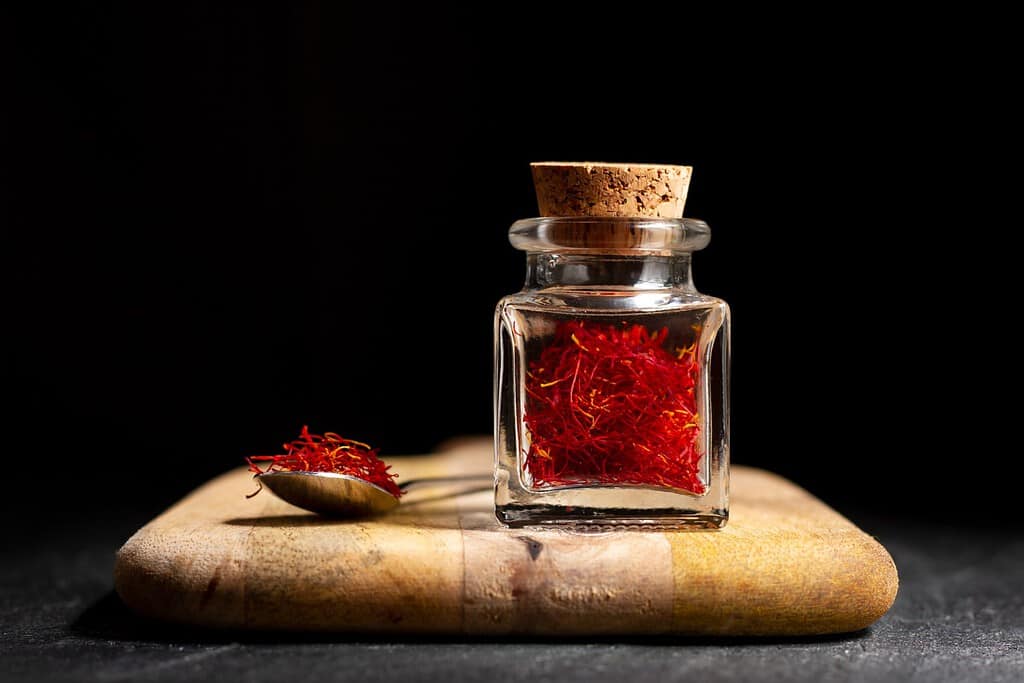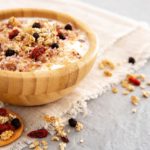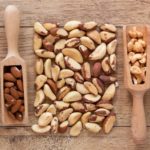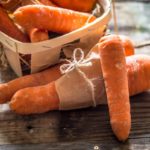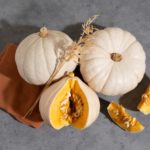
Bernadeth Atrinindarti
MAppSc (Advanced Nutrition Practice)
Statistics show that cancers are on the rise, and while the treatment is costly, there are many studies being conducted to find relatively cheap and effective treatments.
The use of herbal medicine and natural products including herbs and spices is considered a new approach to treating cancer in recent years. They are attributed to having major medicinal properties, cheaper costs and higher safety margins.
In Part I and Part II of the anti-cancer foods series, we explore various types of herbs and spices and their effect on inhibiting the growth of cancer cells, even inducing cancer cell death.
In this article, we will expand our understanding of herbs and spices and their anti-cancer activities.
Panax ginseng
Panax ginseng, also called Korean or Asian ginseng, has been widely used to treat various diseases in Korea and China since ancient times.
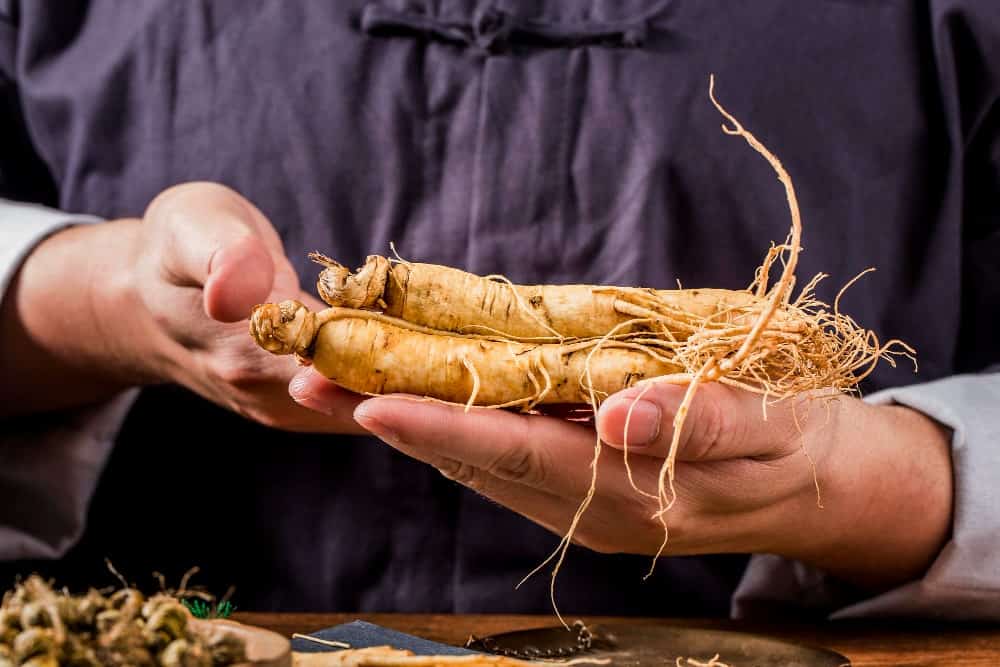
Source: FreePik
Ginsenosides are the main active compound of Panax ginseng that are reported to have therapeutic effects such as being
- anti-inflammatory
- antioxidant
- vasorelaxing
- antiallergic
- anti-cancer
- antidiabetic[1]
RELATED — Diabetes: Early Signs, Causes, Types and Treatment
The major and most studied ginsenosides, called ginsenosides Rh2, have been shown to exhibit positive effects on cancer treatment including alleviating the side effects after chemotherapy and radiotherapy.[2]
A study on Rh2 showed that Rh2 suppresses the rapid increase of human hepatocellular carcinoma cells.
The human hepatocellular carcinoma cells were treated with 10, 20, 40 and 80 µM of ginsenosides Rh2 for 12, 24, 48 and 72 h.[3]

Another study on Rh2 showed that Korean red ginseng (KRG) extract and its main ginsenosides, GRh2, induced apoptosis (cancer cell death) in human hepatocellular carcinoma cell lines.
The cancer cell lines were treated with increasing concentrations of KRG (10–1000 µg/m)l and GRh2 (1–30 µM) for 24h. The result showed that the cancer cell survival rate decreased after the treatment.[4]
Despite its beneficial effect and application in medical studies, these mechanisms of action are still poorly understood and need more research.
Panax notoginseng
Panax notoginseng, known as Chinese ginseng or san-qi ginseng, is a plant that is native to the mountain area in Southwest China.
It has been widely used as a traditional medicine to treat cardiovascular diseases, inflammation, and internal and external bleeding due to injuries.
Panax notoginseng has a similar chemical composition to Panax ginseng but is different in content.
Panax ginseng is known to play a significant role in neuroprotection and cardiovascular disease while Panax notoginseng is more beneficial to diabetes treatment and cerebral protection including stroke treatment.[5]
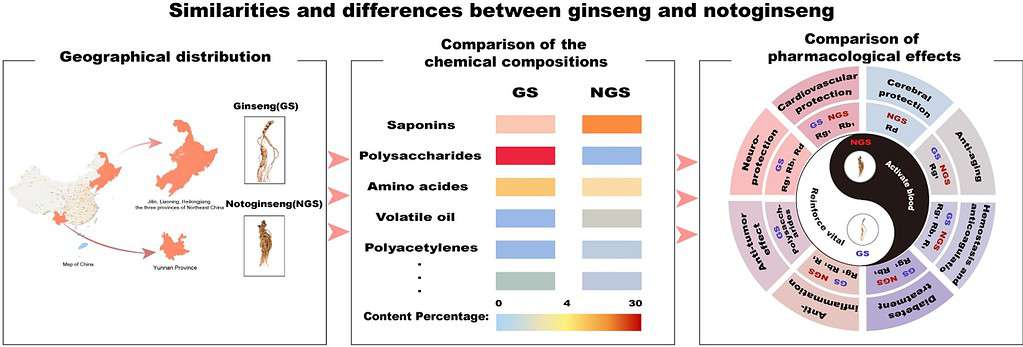
Saponins are the major active compounds of Panax notoginseng and are known to have a beneficial effect on the cardiovascular system, prevent any damage to the liver, and have antioxidant and protective activity against cerebral ischemia.
Panax notoginseng saponins (PNS) have also been shown to inhibit the growth of various tumour cells in vitro and in vivo.
A study by Wang et al. looked at the effect of PNS treatment on the migration of breast cancer in the body. The cancer cells were treated with PNS ranging from 50–200 µg/mL and monitored at 8, 16, and 24 h.
The study reported that Panax notoginseng saponins inhibit the human breast cancer cell line migration with 200 µg/mL of PNS showing the most significant result.[6]
Another study observed the anti-tumour activity of PNS treatment on the Lewis lung carcinoma cell line (LLC).

As we can see from the chart, the results show that the survival rate of the cancer cell lines was reduced after being treated with various concentrations (50, 100, 200, and 400 µg/mL) of PNS.[7]
Parsley
Petroselinum crispum L. or parsley is a herb widely used in East European, Mediterranean and American cuisine. It is high in antioxidants, nutrients, minerals, and dietary fibre.
Parsley has been shown to help control cholesterol levels and protect against free radicals and cancers.[8]
Parsley contains large amounts of apigenin
Apigenin is a flavone known to have anti-inflammatory, antioxidant, antibacterial and antiviral properties and helps with blood pressure reduction. In recent research, apigenin also showed to have a promising effect on cancer treatment.
A study by King et al. showed that apigenin could inhibit cell growth and promote cell death in the human pancreatic carcinoma cell line.
The pancreatic carcinoma cells were treated with apigenin at a dosage of 1–100 uM for 24 hr. The result showed that the number of cell death (apoptosis) increased after the treatment.[9]
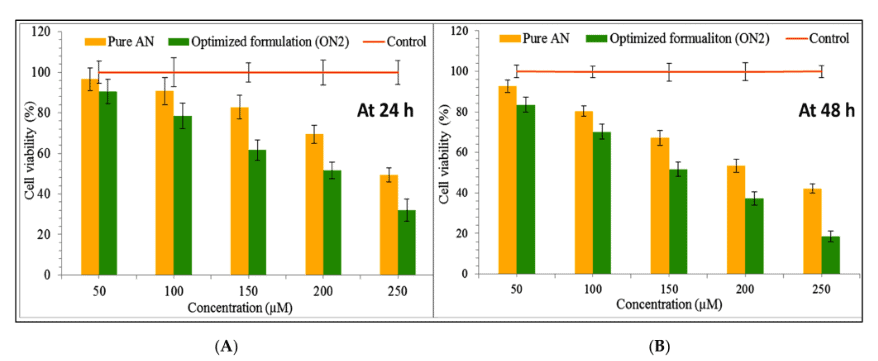
(A) 24 h of study; (B) 48 h of study.
Source: Zafar, A. Development and Optimization of Hybrid Polymeric Nanoparticles of Apigenin: Physicochemical Characterization, Antioxidant Activity and Cytotoxicity Evaluation. (2022)
There was also a study on parsley methanol extract that showed a positive effect on inhibiting human glioblastoma cell reproduction.
Glioblastoma is a type of cancer that starts in the brain and spinal cord.
The results reported that cell reproduction was able to be completely reduced after being treated with 1 µg/mL for 4 days of incubation.[10]
Rosemary
Rosmarinus officinalis L. or known as rosemary is native to the Mediterranean region and has been used as traditional medicine for a very long time.
The major polyphenols found in rosemary extract include diterpenes carnosic acid (CA) and rosmarinic acid (RA). These have been shown to have
- anti-inflammatory
- antidiabetic
- antioxidant, and
- anti-cancer properties
A number of studies on polyphenols in rosemary have been conducted over the years, and a great study to share is on the inhibition of cell growth in human ovarian cancer cells by rosemary extract preparation.
The rosemary extract exhibited a dose-dependent inhibition of cell growth. The result showed rosemary extract could decrease the number of cancer cells up to ~65%.[11]
A study by González-Vallinas et al. showed that rosemary extract could help decrease cell proliferation and induce apoptosis (cell death) in human colorectal adenocarcinoma cell lines.
The cancer cell lines were treated with 20–110 µg/mL rosemary extract for 24 to 48 h.[12]

Source: Jaglanian, A. Rosemary Extract Inhibits Proliferation, Survival, Akt, and mTOR Signaling in Triple-Negative Breast Cancer Cells. (2020)
RELATED — Rosemary (Salvia rosmarinus)
Saffron
Crocus sativus, also known as saffron, is an ancient spice and a natural food dye that has been used to treat various diseases throughout human history.
Saffron was obtained from the dried dark red stigmas of Crocus sativus flowers.[13]
Saffron is known to have antiasthmatic, antidepressant, anti-blood pressure, antioxidant, and anti-inflammatory properties.[14]
A large number of studies on saffron have been conducted to observe the anti-cancer properties of saffron compounds in various types of cancer.
Saffron contains several bioactive compounds such as crocin, crocetin, carotene, safranal, and lycopene which are shown to have antitumour activity by inhibiting cancer cell growth.[15]
One study looked at the effect of safranal (from saffron) on human prostate cancer cells. The human prostate cancer cells were exposed to safranal with different concentrations between 1-3 days.
The result showed a significant decrease in cancer cell viability (survival rate) at concentrations of 15 and 20 µg/mL after 24 h.[16]
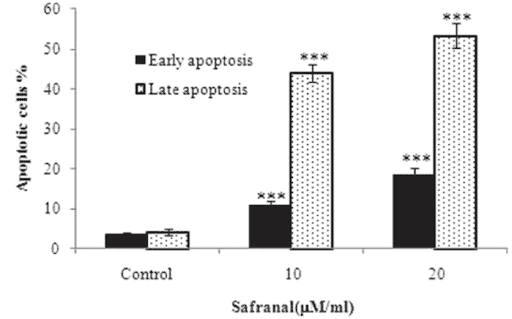
Summary
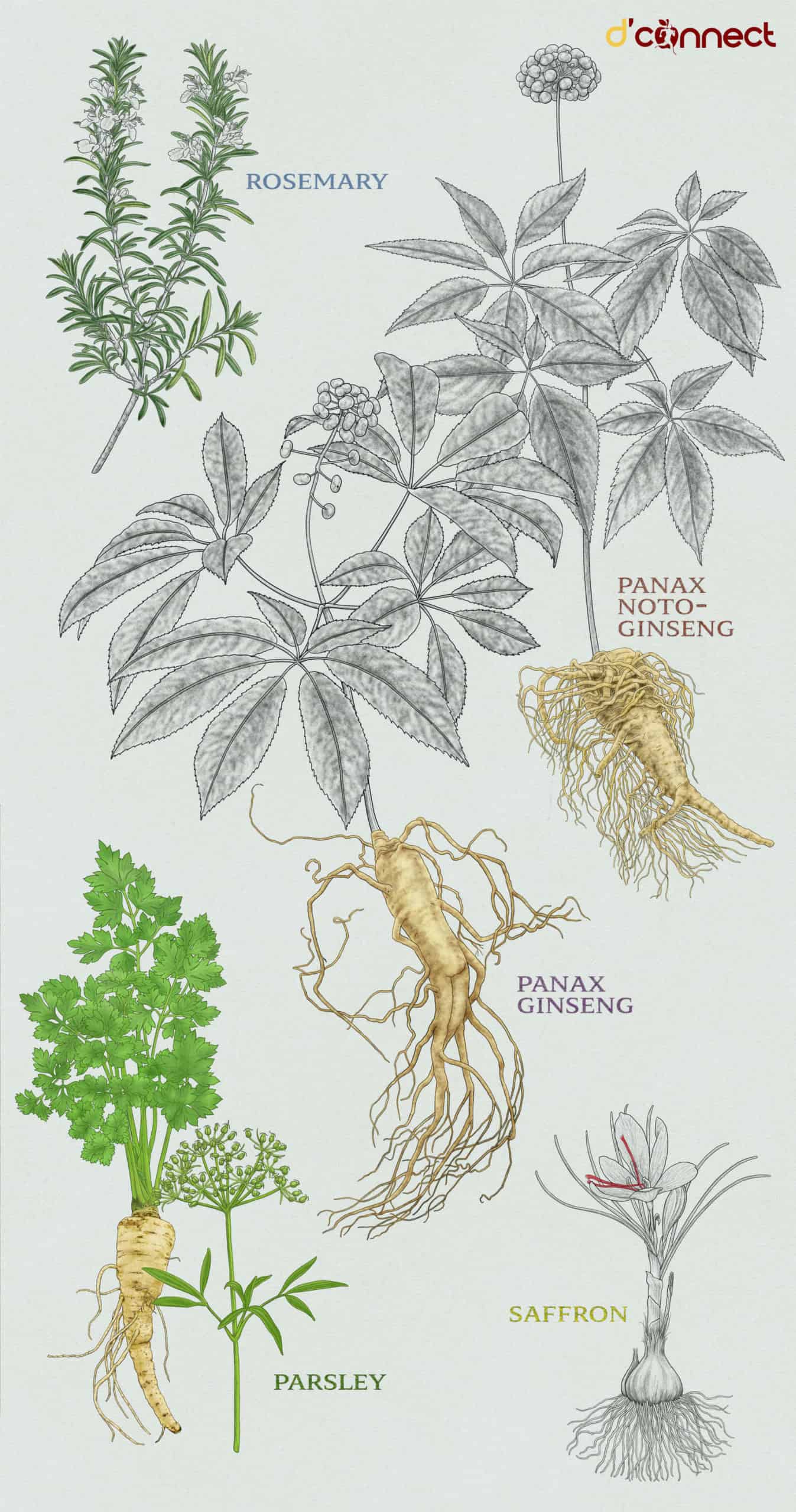
Note — the parts of the plant that are coloured are most often used in extracts.
Related Questions
1. Does diet play a role in cancer?
Yes, diet can play a significant role in developing cancer.
It is known that some cancer risks are higher in consuming
- processed meats
- ultra-processed foods
- large quantities of alcohol
- large quantities of sugar
2. Which cancers feed on ketones?
Ketones and fatty acids could be used in some slow-growing tumour cells.
They can support the tumour cells to ferment glucose and glutamine (a specific type of amino acid) which they then use as their fuel to grow.
However, fatty acids can not help this mechanism outside of the body in the absence of glucose glutamine.
Reports showed that breast cancer can oxidize ketone bodies and fatty acids for growth.
3. What foods should be avoided during chemotherapy?
It is suggested to avoid highly refined and processed foods if you are undergoing chemotherapy.
Also, avoid fried foods because they contain hydrogenated oils which can cause inflammation.
If you would like to include some of these herbs in your kitchen, we suggest checking our Recipes section.
Bernadeth’s passion in cooking, food and health led her to learn more about nutrition and the importance of functional foods. Throughout the years, she gained special interest in sports and performance nutrition, and the varieties of diets around the world. As a nutritionist, Bernadeth’s goal is to encourage a healthy-balanced diet and share the evidence-based nutrition knowledge in order for people to live healthier and longer lives.
Bernadeth is a part of the Content Team that brings you the latest research at D’Connect.
References
(1) Kim J. H. (2018). Pharmacological and medical applications of Panax ginseng and ginsenosides: a review for use in cardiovascular diseases. Journal of ginseng research, 42(3), 264–269. https://doi.org/10.1016/j.jgr.2017.10.004
(2) Li, X., Chu, S., Lin, M., Gao, Y., Liu, Y., Yang, S., Chen, N. (2020). Anticancer property of ginsenoside Rh2 from ginseng. European Journal of Medicinal Chemistry, 203, 112627. doi:https://doi.org/10.1016/j.ejmech.2020.112627
(3) Li, Q., Li, B., Dong, C., Wang, Y., & Li, Q. (2017). 20(S)-Ginsenoside Rh2 suppresses proliferation and migration of hepatocellular carcinoma cells by targeting EZH2 to regulate CDKN2A-2B gene cluster transcription. European Journal of Pharmacology, 815, 173-180. doi:https://doi.org/10.1016/j.ejphar.2017.09.023
(4) Park, H.-M., Kim, S.-J., Kim, J.-S., & Kang, H.-S. (2012). Reactive oxygen species mediated ginsenoside Rg3- and Rh2-induced apoptosis in hepatoma cells through mitochondrial signaling pathways. Food and Chemical Toxicology, 50(8), 2736-2741. doi:https://doi.org/10.1016/j.fct.2012.05.027
(5) Liu, H., Lu, X., Hu, Y., & Fan, X. (2020). Chemical constituents of Panax ginseng and Panax notoginseng explain why they differ in therapeutic efficacy. Pharmacological research, 161, 105263. doi:https://doi.org/10.1016/j.phrs.2020.105263
(6) Wang, P., Cui, J., Du, X., Yang, Q., Jia, C., Xiong, M., Zhang, T. (2014). Panax notoginseng saponins (PNS) inhibits breast cancer metastasis. Journal of Ethnopharmacology, 154(3), 663-671. doi:https://doi.org/10.1016/j.jep.2014.04.037
(7) Yang, Q., Wang, P., Cui, J., Wang, W., Chen, Y., & Zhang, T. (2016). Panax notoginseng saponins attenuate lung cancer growth in part through modulating the level of Met/miR-222 axis. Journal of Ethnopharmacology, 193, 255-265. doi:https://doi.org/10.1016/j.jep.2016.08.040
(8) Ajmera P., Kalani S., Sharma L. (2019). Parsley-benefits & side effects on health. Int J Physiol Nutr Phys Educ. 4(1):1236-1242.
(9) King, J. C., Lu, Q. Y., Li, G., Moro, A., Takahashi, H., Chen, M., Go, V. L., Reber, H. A., Eibl, G., & Hines, O. J. (2012). Evidence for activation of mutated p53 by apigenin in human pancreatic cancer. Biochimica et biophysica acta, 1823(2), 593–604. https://doi.org/10.1016/j.bbamcr.2011.12.008
(10) Nadhem Aissani, Ferdaous Albouchi & Hichem Sebai (2021) Anticancer Effect in Human Glioblastoma and Antioxidant Activity of Petroselinum crispum L. Methanol Extract, Nutrition and Cancer, 73:11-12, 2605-2613, DOI: 10.1080/01635581.2020.1842894
(11) Tai, J., Cheung, S., Wu, M., & Hasman, D. (2012). Antiproliferation effect of Rosemary (Rosmarinus officinalis) on human ovarian cancer cells in vitro. Phytomedicine, 19(5), 436-443. doi:https://doi.org/10.1016/j.phymed.2011.12.012
(12) González-Vallinas, M., Molina, S., Vicente, G., de la Cueva, A., Vargas, T., Santoyo, S., Ramírez de Molina, A. (2013). Antitumor effect of 5-fluorouracil is enhanced by rosemary extract in both drug sensitive and resistant colon cancer cells. Pharmacological research, 72, 61-68. doi:https://doi.org/10.1016/j.phrs.2013.03.010
(13) Samarghandian, S., & Shabestari, M. M. (2013). DNA fragmentation and apoptosis induced by safranal in human prostate cancer cell line. Indian journal of urology : IJU : journal of the Urological Society of India, 29(3), 177–183. https://doi.org/10.4103/0970-1591.117278
(14) Shakeri, M., Hashemi Tayer, A., Shakeri, H., Sotoodeh Jahromi, A., Moradzadeh, M., & Hojjat-Farsangi, M. (2020). Toxicity of Saffron Extracts on Cancer and Normal Cells: A Review Article. Asian Pacific journal of cancer prevention : APJCP, 21(7), 1867–1875. https://doi.org/10.31557/APJCP.2020.21.7.1867
(15) Aung, H. H., Wang, C. Z., Ni, M., Fishbein, A., Mehendale, S. R., Xie, J. T., Shoyama, C. Y., & Yuan, C. S. (2007). Crocin from Crocus sativus possesses significant anti-proliferation effects on human colorectal cancer cells. Experimental oncology, 29(3), 175–180.
(16) Samarghandian, S., & Shabestari, M. M. (2013). DNA fragmentation and apoptosis induced by safranal in human prostate cancer cell line. Indian journal of urology: IJU : journal of the Urological Society of India, 29(3), 177–183. https://doi.org/10.4103/0970-1591.117278
(17) D’Alessandro, A. M., Mancini, A., Lizzi, A. R., De Simone, A., Marroccella, C. E., Gravina, G. L., Tatone, C., & Festuccia, C. (2013). Crocus sativus stigma extract and its major constituent crocin possess significant antiproliferative properties against human prostate cancer. Nutrition and cancer, 65(6), 930–942. https://doi.org/10.1080/01635581.2013.767368

